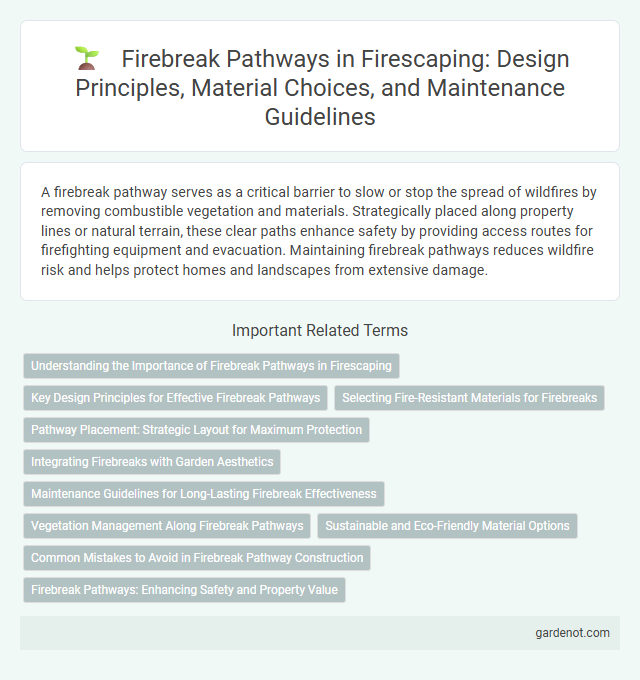A firebreak pathway serves as a critical barrier to slow or stop the spread of wildfires by removing combustible vegetation and materials. Strategically placed along property lines or natural terrain, these clear paths enhance safety by providing access routes for firefighting equipment and evacuation. Maintaining firebreak pathways reduces wildfire risk and helps protect homes and landscapes from extensive damage.
Understanding the Importance of Firebreak Pathways in Firescaping
Firebreak pathways serve as critical barriers that slow or stop the spread of wildfires by removing combustible vegetation and creating cleared zones around properties. These fire-resistant corridors are essential components of firescaping strategies, enhancing safety by providing accessible routes for evacuation and firefighting efforts. Properly designed firebreak pathways minimize fire intensity and protect structures, making them vital for effective wildfire management.
Key Design Principles for Effective Firebreak Pathways
Firebreak pathways should be constructed using non-combustible materials such as gravel, concrete, or bare soil to effectively interrupt fuel continuity and slow wildfire spread. The pathway must be wide enough, typically at least 4 to 6 feet, to serve as a barrier for flames and radiant heat while allowing safe evacuation and firefighting access. Incorporating gentle slopes and maintaining clear visibility enhance safety and accessibility, crucial for effective firebreak functionality.
Selecting Fire-Resistant Materials for Firebreaks
Selecting fire-resistant materials for firebreak pathways significantly enhances wildfire defense by minimizing flammable elements that could ignite or spread fire. Materials such as gravel, crushed stone, concrete, and fire-resistant mulch provide effective barriers by disrupting fuel continuity and heat transfer. Incorporating these non-combustible surfaces into firebreak design increases safety for properties in wildfire-prone areas while facilitating firefighter access.
Pathway Placement: Strategic Layout for Maximum Protection
Placing firebreak pathways strategically involves creating clear, unobstructed zones of low flammability vegetation that disrupt potential wildfire spread around properties. Optimal firebreak layout considers prevailing wind directions, topography, and proximity to structures, ensuring pathways serve as effective barriers and safe evacuation routes. Incorporating materials such as gravel or stone enhances fire resistance, maximizes protection, and supports rapid fire containment.
Integrating Firebreaks with Garden Aesthetics
Firebreak pathways serve as strategic defensible spaces that slow wildfire spread while enhancing garden design through natural materials like stone, gravel, or decomposed granite. Thoughtful integration of fire-resistant plants and organic elements along these firebreaks maintains aesthetic appeal without compromising safety. This approach balances fire protection with visual harmony, promoting both functional landscaping and attractive outdoor environments.
Maintenance Guidelines for Long-Lasting Firebreak Effectiveness
Regularly inspect and clear firebreak pathways of accumulated debris, dry vegetation, and invasive plants to maintain an effective barrier against wildfires. Employ periodic soil stabilization techniques, such as mulching with fire-resistant materials, to prevent erosion and sustain the firebreak's integrity. Consistent maintenance schedules and prompt repairs of any breaches ensure the firebreak remains a reliable defense in fire management strategies.
Vegetation Management Along Firebreak Pathways
Vegetation management along firebreak pathways reduces fuel load by regularly clearing dry leaves, dead branches, and overgrown brush, creating a defensible space that slows wildfire spread. Strategic pruning of trees and shrubs ensures lower canopy density, preventing fire from climbing and intensifying. Maintaining fire-resistant plants and proper spacing along firebreaks optimizes safety and enhances the effectiveness of fire containment efforts.
Sustainable and Eco-Friendly Material Options
Firebreak pathways constructed with sustainable and eco-friendly materials reduce wildfire risk while preserving natural ecosystems. Options such as gravel, decomposed granite, and recycled rubber provide durable, permeable surfaces that minimize soil erosion and promote water absorption. Incorporating native, non-toxic plant mulches alongside these materials enhances fire resistance and supports local biodiversity.
Common Mistakes to Avoid in Firebreak Pathway Construction
Common mistakes in firebreak pathway construction include failing to clear all combustible materials, which undermines the firebreak's effectiveness, and neglecting proper grading and drainage, leading to erosion and pathway damage. Using inappropriate materials, such as flammable vegetation mulch or untreated wood, increases wildfire risk rather than reducing it. Inadequate width and irregular maintenance schedules also compromise firebreak integrity, reducing their ability to protect properties during wildfires.
Firebreak Pathways: Enhancing Safety and Property Value
Firebreak pathways serve as strategic barriers that prevent the spread of wildfires by creating clear, vegetation-free zones around properties. Integrating these pathways into landscape design enhances firefighter access while significantly reducing the risk of fire damage to structures. This proactive measure not only improves safety but also increases property value by demonstrating a commitment to rigorous fire prevention standards.
Firebreak pathway Infographic

 gardenot.com
gardenot.com